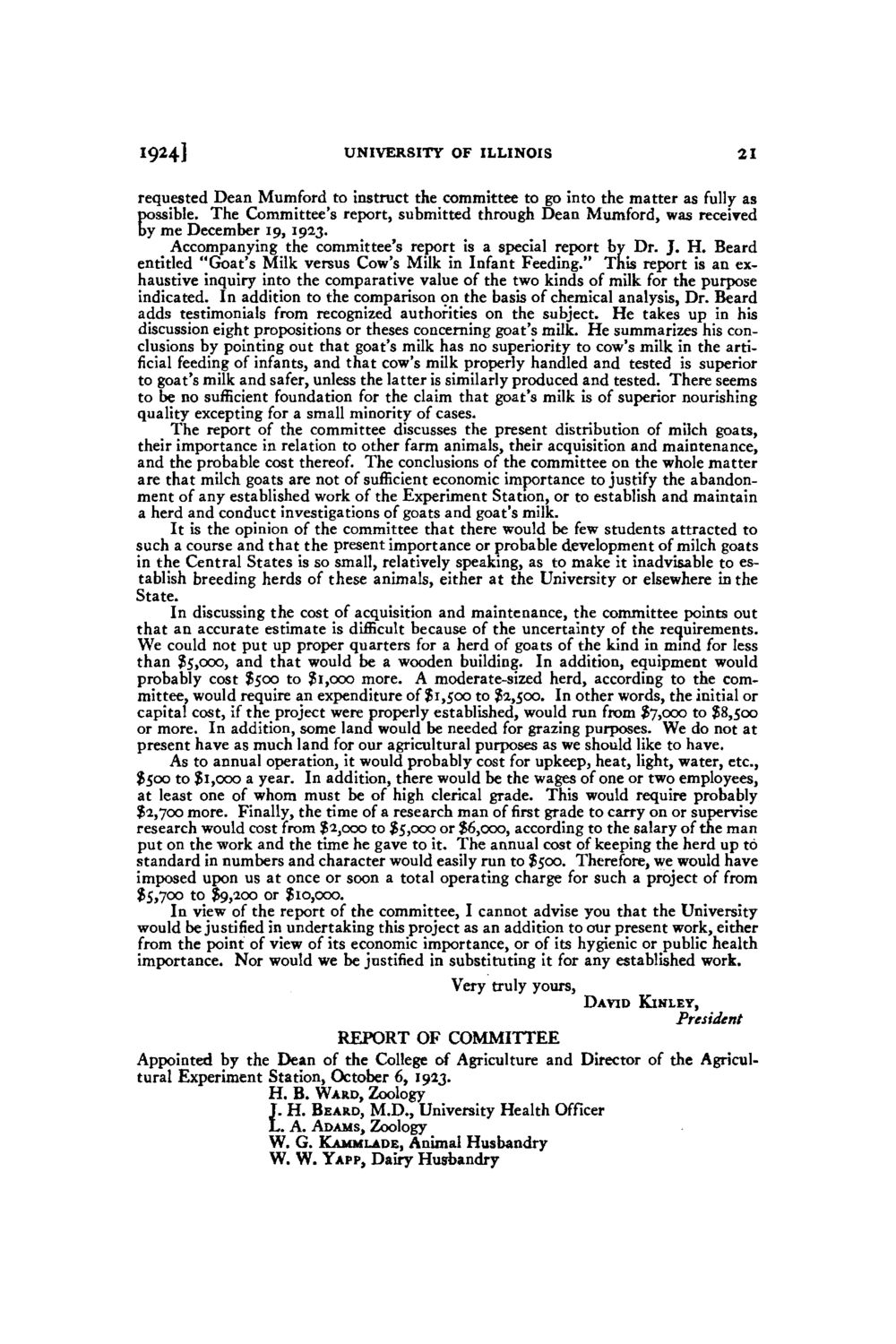| |
| |
Caption: Board of Trustees Minutes - 1926
This is a reduced-resolution page image for fast online browsing.

EXTRACTED TEXT FROM PAGE:
1924] UNIVERSITY O F ILLINOIS 21 requested Dean Mumford to instruct the committee to go into the matter as fully as possible. The Committee's report, submitted through Dean Mumford, was received by m e December 19, 1923. Accompanying the committee's report is a special report by Dr. J. H . Beard entitled "Goat's Milk versus Cow's Milk in Infant Feeding." This report is an exhaustive inquiry into the comparative value of the two kinds of milk for the purpose indicated. In addition to the comparison on the basis of chemical analysis, Dr. Beard adds testimonials from recognized authorities on the subject. H e takes up in his discussion eight propositions or theses concerning goat's milk. H e summarizes his conclusions by pointing out that goat's milk has no superiority to cow's milk in the artificial feeding of infants, and that cow's milk properly handled and tested is superior to goat's milk and safer, unless the latter is similarly produced and tested. There seems to be no sufficient foundation for the claim that goat's milk is of superior nourishing quality excepting for a small minority of cases. The report of the committee discusses the present distribution of milch goats, their importance in relation to other farm animals, their acquisition and maintenance, and the probable cost thereof. The conclusions of the committee on the whole matter are that milch goats are not of sufficient economic importance to justify the abandonment of any established work of the Experiment Station, or to establish and maintain a herd and conduct investigations of goats and goat's milk. It is the opinion of the committee that there would be few students attracted to such a course and that the present importance or probable development of milch goats in the Central States is so small, relatively speaking, as to make it inadvisable to establish breeding herds of these animals, either at the University or elsewhere in the State. In discussing the cost of acquisition and maintenance, the committee points out that an accurate estimate is difficult because of the uncertainty of the requirements. W e could not put up proper quarters for a herd of goats of the kind in mind for less than $5,000, and that would be a wooden building. In addition, equipment would probably cost $500 to $1,000 more. A moderate-sized herd, according to the committee, would require an expenditure of $1,500 to $2,500. In other words, the initial or capital cost, if the project were properly established, would run from $7,000 to $8,500 or more. In addition, some land would be needed for grazing purposes. W e do not at present have as much land for our agricultural purposes as we should like to have. As to annual operation, it would probably cost for upkeep, heat, light, water, etc., $500 to $1,000 a year. In addition, there would be the wages of one or two employees, at least one of w h o m must be of high clerical grade. This would require probably $2,700 more. Finally, the time of a research m a n of first grade to carry on or supervise research would cost from $2,000 to $5,000 or $6,000, according to the salary of the man put on the work and the time he gave to it. The annual cost of keeping the herd up to standard in numbers and character would easily run to $500. Therefore, we would have imposed upon us at once or soon a total operating charge for such a project of from $5,700 to $9,200 or $10,000. In view of the report of the committee, I cannot advise you that the University would be justified in undertaking this project as an addition to our present work, either from the point of view of its economic importance, or of its hygienic or public health importance. Nor would we be justified in substituting it for any established work. Very truly yours, David Kinley, President REPORT OF COMMITTEE Appointed by the Dean of the College of Agriculture and Director of the Agricultural Experiment Station, October 6, 1923. H. B. Ward, Zoology T. G. Kammlade, Animal Husbandry W . H. Adams, Dairy Husbandry L. A..Beard,ZoologyUniversity Health Officer W Yapp, M.D.,
| |